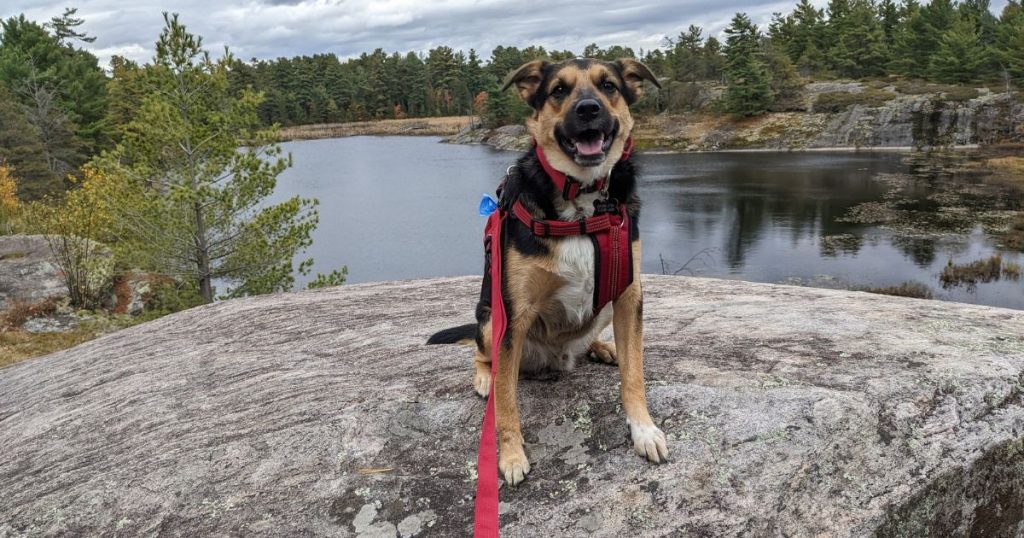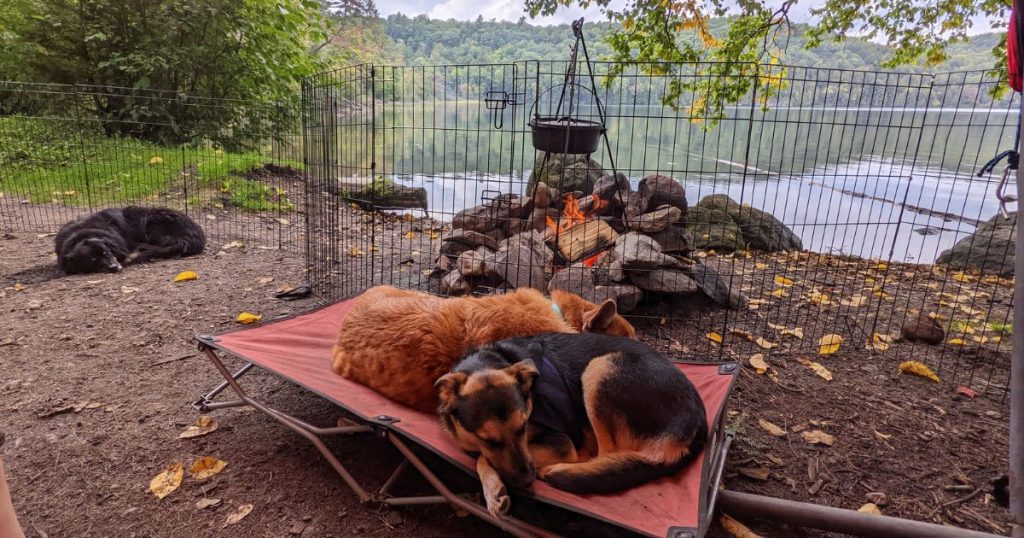Bear Safety When Camping with Pets
For many out there, the idea of camping in bear territory is a frightening idea. These large creatures are fascinating to watch, but only at a safe distance! But over 90% of Ontario Parks are in bear country.
Don’t let that stop you from getting out and enjoying the natural beauty!
Today, we’re going to look at the basics of bear safety when camping – more importantly, we’re going to look at the unique considerations when camping with your pets!

This post contains affiliate links, which means if you click and buy, we will make a commission (at no cost to you). See my full disclosure policy for more details.
Can You Go Tent Camping in Bear Country with Pets?
It’s a question that we have heard quite often, especially when people hear that we take our cats tent camping with us. Can you go tent camping in bear country with pets? While there are some extra safety considerations when bringing your pets along, camping in bear country can be a fun and safe experience!
The most important thing to remember is not to take anything for granted!
Bears are opportunistic, meaning that they are looking for a quick, easy meal. If your campsite is set up in a way that offers that, there is a good chance you will see a visitor at some point during your trip. However, if you take precautions, you can greatly reduce this chance.
How to Bear-Proof Your Campsite
Keep Food and Food-Related Items Safely Stored
The most important thing that you can do to bear-proof your campsite is to keep all food and food-related items safely stored away any time that they are not in use. This is such an important point that it was posted in every building and bathroom while we were at Grundy Lake Provincial Park last weekend.
This includes:
- Food and coolers
- Pet food and treats
- Garbage
- Recycling
- Toiletries
- Barbeques and camp stoves
- Drinks, cans, and bottles
- Dishes, both clean and dirty
- Storage totes or boxes
If you are backcountry camping, these items should be kept in a food storage locker (provided in some parks) or hung from a food-hanging tree. The tree you choose should be at least 100 metres from the campsite where you will be sleeping and hung at least 2 metres from the tree trunk and 4 metres off the ground.
If you are car camping in bear country, you can keep these items safely stored in your vehicle.
While bears can climb trees and may still access your food and garbage, the extra effort needed to access food that is hung properly is highly effective in deterring them. Don’t forget your pet’s food and food dishes! When cleaning up your campsite, any pet food, pet treats, or dishes related to feeding your pet should be treated the same as your own food. Pay careful attention to the area around your dog’s food dish in case your dog may have dropped a spare kibble. This is especially common with older dogs who may be losing their sight or sense of smell with age.
Clean Up After Your Dog or Cat
Another important point to consider in terms of bear safety when camping is where your pet is doing their ‘business’.
For pets that are allowed to go to the bathroom outdoors, around your site, make sure to clean up any messes as soon as you notice that they happen. Pack plenty of pet waste bags before heading out so that you can pick up any droppings. These should be safely stored with the rest of your garbage as your dog or cat’s poop could attract bears just like food would.
If you are camping with cats, there is also a litterbox to consider. Your cat’s litterbox should be scooped regularly throughout the day, especially if you know that your cat has gone to the bathroom.
Before sleeping each night, especially if you are sleeping in a tent or tent trailer in a high-risk area, do a complete change of your cat’s litter. The litter left behind from scooping can still carry scents that could attract bears. This can be done by using disposable litter boxes or with the use of a litterbox liner. Make sure all waste is properly stored away with the garbage.

Properly Dispose of Grey Water
This is an often-overlooked concern when camping with bears. But grey water also introduces tempting smells to your campsite that could attract a bear. This includes any water except for that associated with human waste (black water) such as dishwater, handwash basins, and water left over from cooking. One important consideration for bear safety when camping is how you are disposing of this grey water.
If you are camping in a trailer or RV, you may have a grey water tank that safely keeps this stored away. But for those tent camping (like we do), grey water disposal is an important consideration.
All grey water should be collected throughout the day. This means not dumping the dish bin after cleaning your dishes or even rinsing out a glass, discarding the water into the bush. The best way we find to do this is to keep a bucket nearby when washing dishes or cooking to empty grey water into for disposal.
If you are car camping, grey water should be dumped in the vault toilets. For those that prefer more rustic backcountry camping, dig a hole away from your main campsite and bury your grey water.
Keep Campsite ‘Zones’ Safely Distanced
When setting out where you are going to carry out your daily routine at your campsite, you should consider the primary ‘zones’ that you will need. This includes the cooking/dining zone, the sleeping zone, and the food storage zone. The best approach for bear safety when camping is to keep all 3 of these zones safely distanced from one another. Experts recommend at least 50 metres between zones.
This means you should never eat in or near your tent. Instead, keep all activities related to food (cooking, eating, or feeding your pet) in a separate area distanced from your tent. This will stop the food smells from attracting a bear to where you sleep.
Keep Your Pets Safely Contained
This is often a controversial topic for pet owners, especially dog owners. While I am an advocate for the availability of off-leash dog beaches and exercise areas, there are some situations where it’s safer for everyone involved to have your pet safely contained or on a leash. This is the perfect example.
A pet that wanders off into the bush may encounter a bear. Not only could this create an unsafe situation for your pet in the moment, but they may agitate the bear or lead it back to your campsite.
If you don’t want to keep your dog leashed the entire time, there are options for using an exercise pen when car camping. If you are heading out to the backcountry, stick with a leash or reliable long lead unless your dog has 110% reliable recall and doesn’t tend to wander.
This is where the responsibility falls on you to be 110% honest with yourself about your dog’s obedience. If you are unsure, keep your dog contained and don’t take chances with their safety.

What to Do if a Bear Comes onto Your Campsite
The most important thing to do if you see or suspect a bear on your campsite is to remain calm. Take a deep breath before reacting. The best thing that you can do is to give the bear space. This means not approaching it, not blocking it’s escape path, and avoiding getting between the bear and its cubs during that time of year.
If you are in a situation where you can see the bear and they can see you, avoid running or staring it down. The best approach will depend on what type of bear you have encountered.
If the bear is a black bear, raise your arms to look larger and make a lot of noise. This could be done by blowing a whistle, banging on pots or other objects, throwing objects in it’s general direction or shouting ‘hey bear’. Most black bears will recognize that you are not prey and retreat.
However, if you are attacked by a grizzly bear, the approach is different. A grizzly that charges you is trying to scare you off and you don’t want to portray yourself as a threat. Instead, talk to the bear calmly and prepare to defend yourself with bear spray.
Which is Better – Bear Spray or Pepper Spray?
One myth that we have heard is that you can bring normal pepper spray on your adventures and use it as an alternative to bear spray. But the two products are not the same and shouldn’t be used interchangeably. While most pepper sprays can spray approximately 10 feet, bear sprays are designed to work at a greater distance. This is important to avoid getting too close to an angry bear should the situation arise. Bear spray offers a spray range of up to 35 feet.
Cans of bear spray are also under greater pressure, meaning that they will come out faster and with more force.
Here in Canada, carrying Pepper spray is illegal. This is due to the fact that it is considered to be a prohibited weapon under the Criminal Code. Bear spray, with the intention of use to protect yourself from bears (not humans) is fully legal.
If you’re unfamiliar with how to use bear spray safely, check out this video from WildSafeBC:
Bear spray: Safe use and deployment from WildSafeBC on Vimeo.

Have you ever camped in bear country? If so, what steps do you take to prioritize bear safety when camping?
